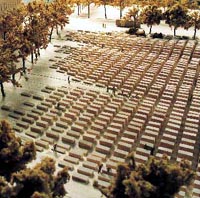18 November 2003
What Matters
From the San Francisco Chronicle, November 13, 2003:
Provocateur becomes a pragmatist
“‘We’re into Looney Tunes’ is how Eisenman described current design trends to a nearly full house at Yerba Buena Center for the Arts. ‘Ultimately, architecture is not about putting images in the New York Times, but about creating places for people to be.... Architecture has gotten more and more frenetic. It has spun out of control.’...
‘The New York Times demands these [unconventional] images because dumb, straightforward images don’t sell papers,’ Eisenman said, but he also took a bit of the blame: ‘I’m probably partly responsible. I’m not pointing fingers.’
What shifted his perspective, one senses, was the rending experience of Sept. 11, 2001. Eisenman and his family saw the second plane hit, and his son still won’t go in their building’s elevator alone. ‘He walks up 21 floors. We say, “Hey, Sam, that’s a little crazy, there won’t be an attack because you’re in an elevator,” but he feels threatened.’
 So when Eisenman says that ‘we need to rethink architecture after 9/11,’ his starting point is something more vivid than any sort of intellectual theory: He was there. And amid all the tragic losses of the terrorist attacks was a reminder that buildings, neighborhoods, cities aren’t abstractions or metaphysical conceits — they are real, and they are where people live and die.
So when Eisenman says that ‘we need to rethink architecture after 9/11,’ his starting point is something more vivid than any sort of intellectual theory: He was there. And amid all the tragic losses of the terrorist attacks was a reminder that buildings, neighborhoods, cities aren’t abstractions or metaphysical conceits — they are real, and they are where people live and die.
‘The experience of being in that place was very different than watching it [the attack] in Berlin, Tokyo, Madrid, whatever,’ Eisenman said.
Even with this shift in perception, it’s hard to imagine Eisenman leading a back-to-basics movement. He’s too dazzled by the new; later in the lecture, for instance, he enthused about how computers can record design patterns and then replicate them like a virus. Lines generated onscreen ‘can have a direction, a force, an intensity... they start to be more organic.’
And yet the lecture ended with a subtle surprise. It was Eisenman’s design for a train station near Naples, and it was a word that probably has never been associated with his work: lovely. ...
After the talk, Eisenman relaxed at a small dinner hosted by the local branch of the American Institution of Architects, one of the lecture’s sponsors. And he talked about... concrete.
Specifically, he expounded on the chore of making sure the 2,751 huge pillars at his Memorial to the Murdered Jews of Europe in Berlin have the proper look and feel. So Eisenman finds himself in Berlin at least once each month confronting workers over the quality of their mortar and mixed cement.
‘I used to say that what finally got built didn’t matter — what counted was the design as I saw it in my head,’ he said, then chuckled. ‘I can’t believe I ever thought that.’”

